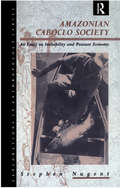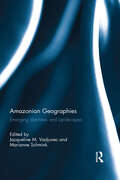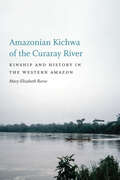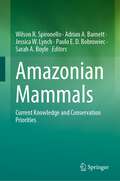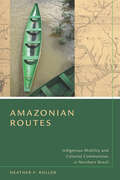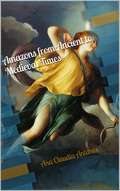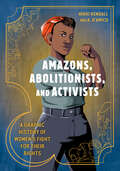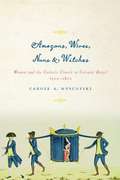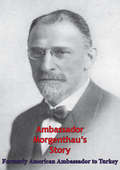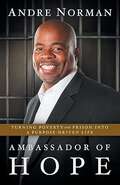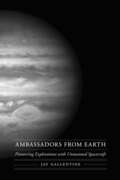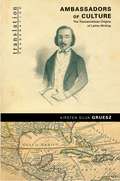- Table View
- List View
Amazonia, Landscape and Species Evolution
by Frank Wesselingh Carina HoornThe book focuses on geological history as the critical factor in determining the present biodiversity and landscapes of Amazonia. The different driving mechanisms for landscape evolution are explored by reviewing the history of the Amazonian Craton, the associated sedimentary basins, and the role of mountain uplift and climate change.This book provdes an insight into the Meso- and Cenozoic record of Amazonia that was characterized by fluvial and long-lived lake systems and a highly diverse flora and fauna. This fauna includes giants such as the ca. 12 m long caiman Purussaurus, but also a varied fish fauna and fragile molluscs, whilst fossil pollen and spores form relics of ancestral swamps and rainforests.Finally, a review the molecular datasets of the modern Amazonian rainforest and aquatic ecosystem, discussing the possible relations between the origin of Amazonian species diversity and the palaeogeographic, palaeoclimatic and palaeoenvironmental evolution of northern South America. The multidisciplinary approach in evaluating the history of Amazonia has resulted in a comprehensive volume that provides novel insights into the evolution of this region.
Amazonia: Five Years at the Epicenter of the Dot.Com Juggernaut
by James MarcusFive years at the epicenter of the dot.com juggernaut
Amazonia: Five Years at the Epicenter of the Dot.com Juggernaut
by James MarcusA &“funny, contemplative&” memoir of working at Amazon in the early years, when it was a struggling online bookstore (San Francisco Chronicle). In a book that Ian Frazier has called &“a fascinating and sometimes hair-raising morality tale from deep inside the Internet boom,&” James Marcus, hired by Amazon.com in 1996—when the company was so small his e-mail address could be james@amazon.com—looks back at the ecstatic rise, dramatic fall, and remarkable comeback of the consummate symbol of late 1990s America. Observing &“how it was to be in the right place (Seattle) at the right time (the &’90s)&” (Chicago Reader), Marcus offers a ringside seat on everything from his first interview with Jeff Bezos to the company&’s bizarre Nordic-style retreats, in &“a clear-eyed, first-person account, rife with digressions on the larger cultural meaning throughout&” (Henry Alford, Newsday). &“Marcus tells his story with wit and candor.&” —Booklist, starred review
Amazonian Caboclo Society: An Essay on Invisibility and Peasant Economy (Explorations in Anthropology)
by Stephen NugentAmazonian Caboclo Society is concerned with peasant society in Brazilian Amazonia. Most anthropological work in Amazonia has focused on Indian groups, and caboclos (peasants of mixed ancestry) have generally been regarded as relics of the haphazard development of Amazonia and have received little serious attention. This volume aims to analyze the reasons for the relative 'invisibility' of caboclo society. It traces the development of caboclo societies and argues that much of the current discussion of 'sustainable development' fails to recognize the important legacy of historical caboclo society.
Amazonian Cosmopolitans: Navigating a Shamanic Cosmos, Shifting Indigenous Policies, and Other Modern Projects
by Suzanne OakdaleAmazonian Cosmopolitans focuses on the autobiographical accounts of two Brazilian Indigenous leaders, Prepori and Sabino, Kawaiwete men whose lives spanned the twentieth century, when Amazonia increasingly became the context of large-scale state projects. Both give accounts of how they worked in a range of interethnic enterprises from the 1920s to the 1960s in central Brazil. Prepori, a shaman, also gives an account of his relations with spirit beings that populate the Kawaiwete cosmos as he participated in these projects. Like other Indigenous Amazonians, Kawaiwete value engagement with outsiders, particularly for leaders and shamanic healers. These social engagements encourage a careful watching and learning of others&’ habits, customs, and sometimes languages, what could be called a kind of cosmopolitanism or an attitude of openness, leading to an expansion of the boundaries of community. The historical consciousness presented by these narrators centers on how transformations in social relations were experienced in bodily terms—how their bodies changed as new relationships formed. Amazonian Cosmopolitans offers Indigenous perspectives on twentieth-century Brazilian history as well as a way to reimagine lowland peoples as living within vast networks, bridging wide social and cosmological divides.
Amazonian Floodplain Forests: Ecophysiology, Biodiversity and Sustainable Management (Ecological Studies #210)
by Florian Wittmann Jochen Schöngart Maria T. Piedade Pia Parolin Wolfgang J. JunkCentral Amazonian floodplain forests are an unique and endangered ecosystem. The forests grow in areas that are annually flooded by large rivers during mean periods of up to 8 months and at depths of up to 10 m. Despite this severe stress, these forests consist of over 1,000 species and are by far the most species-rich floodplain forests worldwide. The trees show a broad range of morphological, anatomical, physiological, and phenological adaptations that enable them not only to survive the adverse environmental conditions, but also to produce large amounts of biomass when the nutrient levels in water and soils are sufficiently high. This is the case in the floodplains of white-water rivers, which are used for fisheries, agriculture, and cattle-ranching but which also have a high potential for the production of timber and non-timber products, when adequately managed. Latest research on ecophysiology gives insight how tree species adapt to the oscillating flood-pulse focusing on their photosynthesis, respiration, sap flow, biochemistry, phenology, wood and leave anatomy, root morphology and functioning, fruit chemistry, seed germination, seedling establishment, nitrogen fixation and genetic variability. Based on tree ages, lifetime growth rates and net primary production, new concepts are developed to improve the sustainability of traditional forest managements in the background of an integrated natural resource management. This is the first integrative book on the functioning and ecologically oriented use of floodplain forests in the tropics and sub-tropics.It provides fundamental knowledge for scientist, students, foresters and other professionals on their distribution, evolution and phytogeography. "This book is an excellent testimony to the interdisciplinary collaboration of a group of very dedicated scientists to unravel the functioning of the Amazonian Floodplain forests. They have brought together a highly valuable contribution on the distribution, ecology, primary production, ecophysiology, typology, biodiversity, and human use of these forests offering recommendations for sustainable management and future projects in science and development of these unique wetland ecosystems. It lays a solid scientific foundation for wetland ecologists, foresters, environmentalists, wetland managers, and all those interested in sustainable management in the tropics and subtropics." Brij Gopal, Executive Vice President International Society for Limnology (SIL).
Amazonian Geographies: Emerging Identities and Landscapes
by Jacqueline M. Vadjunec and Marianne SchminkAmazonia exists in our imagination as well as on the ground. It is a mysterious and powerful construct in our psyches yet shares multiple (trans)national borders and diverse ecological and cultural landscapes. It is often presented as a seemingly homogeneous place: a lush tropical jungle teeming with exotic wildlife and plant diversity, as well as the various indigenous populations that inhabit the region. Yet, since Conquest, Amazonia has been linked to the global market and, after a long and varied history of colonization and development projects, Amazonia is peopled by many distinct cultural groups who remain largely invisible to the outside world despite their increasing integration into global markets and global politics. Millions of rubber tappers, neo-native groups, peasants, river dwellers, and urban residents continue to shape and re-shape the cultural landscape as they adapt their livelihood practices and political strategies in response to changing markets and shifting linkages with political and economic actors at local, regional, national, and international levels.This book explores the diversity of changing identities and cultural landscapes emerging in different corners of this rapidly changing region.This book was published as a special issue of the Journal of Cultural Geography.
Amazonian Kichwa of the Curaray River: Kinship and History in the Western Amazon
by Mary-Elizabeth ReeveAmazonian Kichwa of the Curaray River is an exploration of the dynamics of regional societies and the ways in which kinship relationships define the scale of these societies. It details social relations across Kichwa-speaking indigenous communities and among neighboring members of other ethnolinguistic groups to explore the multiple ways in which the regional society is conceptualized among Amazonian Kichwa. Drawing on recent studies in kinship, landscape from an indigenous perspective, and social scaling, Mary-Elizabeth Reeve presents a view of Amazonian Kichwa as embedded in a multiethnic regional society of great historic depth. This book is a fine-grained ethnography of the Kichwa of the Curaray River region (Curaray Runa) in which Reeve focuses on ideas of social landscape, as well as residence, extended kin groups, historical memory, and collective ritual celebration, to show the many ways in which Curaray Runa express their placement within a regional society. The final chapter examines social scaling as it is currently unfolding in indigenous societies in Amazonian Ecuador through increasing multisited residence and political mobilization. Based on intensive fieldwork, Amazonian Kichwa of the Curaray River breaks new ground in Amazonian studies by focusing on extended kinship networks at a larger scale and by utilizing both ethnographic and archival research of Amazonian regional systems.
Amazonian Mammals: Current Knowledge and Conservation Priorities
by Adrian A. Barnett Wilson R. Spironello Jessica W. Lynch Paulo E. D. Bobrowiec Sarah A. BoyleThe mammal fauna of the Brazilian Amazon is one of the most diverse on Earth with over 450 known species. Bringing together more than 70 of the world’s top experts on Amazonian mammals, this book unites, for the first time, up-to-date data on the current state of knowledge on the ecology of all groups of non-rodent mammals in the Brazilian Amazon, analyses the effectiveness of current conservation programmes and identifies research and conservation priorities for the future.
Amazonian Routes: Indigenous Mobility and Colonial Communities in Northern Brazil
by Heather F. RollerThis book reconstructs the world of eighteenth-century Amazonia to argue that indigenous mobility did not undermine settlement or community. In doing so, it revises longstanding views of native Amazonians as perpetual wanderers, lacking attachment to place and likely to flee at the slightest provocation. Instead, native Amazonians used traditional as well as new, colonial forms of spatial mobility to build enduring communities under the constraints of Portuguese colonialism. Canoeing and trekking through the interior to collect forest products or to contact independent native groups, Indians expanded their social networks, found economic opportunities, and brought new people and resources back to the colonial villages. When they were not participating in these state-sponsored expeditions, many Indians migrated between colonial settlements, seeking to be incorporated as productive members of their chosen communities. Drawing on largely untapped village-level sources, the book shows that mobile people remained attached to their home communities and committed to the preservation of their lands and assets. This argument still matters today, and not just to scholars, as rural communities in the Brazilian Amazon find themselves threatened by powerful outsiders who argue that their mobility invalidates their claims to territory.
Amazons From Ancient To Medieval Times (The Memoirs Of An Amazon Series Book #1)
by Ana Bowlova Ana Claudia AntunesHow Amazons entered the imaginary to become legends? You will expand your knowledge from ancient Greece until the Middle Ages with first-person accounts about the Amazons, what they did, who they met, the risks and dangers suffering until they became true living legends. A Tale highly engaging, moving and shocking at the same time that will make you wonder if all this was really true or just part of a collective soul. Dreams, fantasies, goddesses who lived on Earth long before it was colonized? Feel part of the world of Amazon in this book that reveals the synthesis of human knowledge within the collective consciousness.First book from Memoirs of an Amazon Series which includes two more books:Amazons in Medieval EuropeAmazon TodayHappy reading/riding!
Amazons in America: Matriarchs, Utopians, and Wonder Women in U.S. Popular Culture
by Keira V. WilliamsWith this remarkable study, historian Keira V. Williams shows how fictional matriarchies—produced for specific audiences in successive eras and across multiple media—constitute prescriptive, solution-oriented thought experiments directed at contemporary social issues. In the process, Amazons in America uncovers a rich tradition of matriarchal popular culture in the United States. Beginning with late-nineteenth-century anthropological studies, which theorized a universal prehistoric matriarchy, Williams explores how representations of women-centered societies reveal changing ideas of gender and power over the course of the twentieth century and into the present day. She examines a deep archive of cultural artifacts, both familiar and obscure, including L. Frank Baum’s The Wizard of Oz series, Progressive-era fiction like Charlotte Perkins Gilman’s utopian novel Herland, the original 1940s Wonder Woman comics, midcentury films featuring nuclear families, and feminist science fiction novels from the 1970s that invented prehistoric and futuristic matriarchal societies. While such texts have, at times, served as sites of feminist theory, Williams unpacks their cyclical nature and, in doing so, pinpoints some of the premises that have historically hindered gender equality in the United States. Williams also delves into popular works from the twenty-first century, such as Tyler Perry’s Madea franchise and DC Comics/Warner Bros.’ globally successful film Wonder Woman, which attest to the ongoing presence of matriarchal ideas and their capacity for combating patriarchy and white nationalism with visions of rebellion and liberation. Amazons in America provides an indispensable critique of how anxieties and fantasies about women in power are culturally expressed, ultimately informing a broader discussion about how to nurture a stable, equitable society.
Amazons, Abolitionists, and Activists: A Graphic History of Women's Fight for Their Rights
by Mikki KendallA bold and gripping graphic history of the fight for women&’s rights by the New York Times bestselling author of Hood Feminism &“A beautifully drawn, hold-no-punches, surprisingly deep dive through the history of women's rights around the world, which will entrance kids and adults alike.&”—N. K. Jemisin, Hugo Award–winning author of the Broken Earth trilogy The ongoing struggle for women&’s rights has spanned human history, touched nearly every culture on Earth, and encompassed a wide range of issues, such as the right to vote, work, get an education, own property, exercise bodily autonomy, and beyond. Amazons, Abolitionists, and Activists is a fun and fascinating graphic novel–style primer that covers the key figures and events that have advanced women&’s rights from antiquity to the modern era. In addition, this compelling book illuminates the stories of notable women throughout history—from queens and freedom fighters to warriors and spies—and the progressive movements led by women that have shaped history, including abolition, suffrage, labor, civil rights, LGBTQ liberation, reproductive rights, and more. Examining where we've been, where we are, and where we're going, Amazons, Abolitionists, and Activists is an indispensable resource for people of all genders interested in the fight for a more liberated future.
Amazons, Wives, Nuns, and Witches: Women and the Catholic Church in Colonial Brazil, 1500-1822
by Carole A. MyscofskiThe Roman Catholic church played a dominant role in colonial Brazil, so that women's lives in the colony were shaped and constrained by the Church's ideals for pure women, as well as by parallel concepts in the Iberian honor code for women. Records left by Jesuit missionaries, Roman Catholic church officials, and Portuguese Inquisitors make clear that women's daily lives and their opportunities for marriage, education, and religious practice were sharply circumscribed throughout the colonial period. Yet these same documents also provide evocative glimpses of the religious beliefs and practices that were especially cherished or independently developed by women for their own use, constituting a separate world for wives, mothers, concubines, nuns, and witches. Drawing on extensive original research in primary manuscript and printed sources from Brazilian libraries and archives, as well as secondary Brazilian historical works, Carole Myscofski proposes to write Brazilian women back into history, to understand how they lived their lives within the society created by the Portuguese imperial government and Luso-Catholic ecclesiastical institutions. Myscofski offers detailed explorations of the Catholic colonial views of the ideal woman, the patterns in women's education, the religious views on marriage and sexuality, the history of women's convents and retreat houses, and the development of magical practices among women in that era. One of the few wide-ranging histories of women in colonial Latin America, this book makes a crucial contribution to our knowledge of the early modern Atlantic World.
Amazons: The History Behind the Legend
by David BraundThe idea of the Amazons is one of the most romantic and resonant in all antiquity. Greeks were fascinated by images and tales of these fierce female fighters. At Troy, Achilles' duel with Penthesilea was a clash of superman and superwoman. Achilles won the fight, but the queen's dying beauty had torn into his soul. This vibrant new book offers the first complete picture of the reality behind the legends. It shows there was much more to the Amazons than a race of implacable warrior women. David Braund casts the Amazons in a new light: as figures of potent agency, founders of cities, guileful and clever as well as physically impressive and sexually alluring to men. Black Sea mythologies become key to unlocking the Amazons' mystery. Investigating legend through history, literature, and archaeology, the author uncovers a truth as surprising and evocative as any fiction told through story or myth.
Amazon®: How Jeff Bezos Built the World's Largest Online Store
by Aurelia JacksonToday, Amazon.com is the world's most successful online store, selling everything from hand soap to computer parts, from books to children's toys. But Amazon wasn't always the amazing success it is now. Years ago, Amazon.com was just the dream of one person: Jeff Bezos. Learn about the man behind one of the most successful online businesses of all time. Discover how he started Amazon and led the company to incredible success. Find out how Jeff and Amazon are planning to change the future of online shopping.
Ambani
by N. ChokkanThis book is a biography of Dhirubai Ambani who won the prestigious best industrialist of India of the 20th century award from "Business Barons" in 1999 and who started his life from a humble beginning with moderate education to achieve Himalayan victory in business world with high enterprising ability.
Ambani: Oru Vetri Kadhai
by N. ChokkanThis book tells the success story of the Indian industrialist Dhirubai Ambani.
Ambassador Morgenthau’s Story [Illustrated Edition]
by Henry MorgenthauIllustrated with 54 photographs and portraits.The memoirs of the American Ambassador to Turkey during the First World War, covering the political dealing at the top of the Ottoman Empire and the events of the Armenian disaster.The Memoirs of Henry Morgenthau Sr. cover the period that he was in office as United States Ambassador to the Ottoman Empire; his memoirs reflect on the two moments events that characterized the period. The first event was of course World War that raged on throughout his tenure and he records how he sought to ensure the safety of the American citizens in the Empire as well as serving as much as possible the interests of the Allied nations whose embassies had been withdrawn. His anecdotes of the German and Turkish generals and ministers who inhabited the highest echelons are well worth reading and a rarity in English.The Second event was the Armenian massacres which are now overshadowed by the Holocaust of the Jews during the Second World War, however the suffering of the Armenian minority that were targeted by the Ottoman Empire's policy was just as great a crime against humanity; indeed the very word 'Genocide' was coined to describe this terrible period. Few books in English describe the awful suffering of this period of the First World War, however the author wrote voluminously of the incidents and even toured the affected areas. His memoirs are perhaps the best first-hand details of this terrible event by a neutral outsider, on an issue that remains contentious to this day.
Ambassador of Hope: Turning Poverty and Prison into a Purpose-Driven Life
by Andre NormanAndre Norman’s early life put him on a path to prison. Raised in poverty and surrounded by dysfunction, Andre gravitated to his neighborhood gang. His choices there led to time in juvenile detention, and eventually a maximum-security prison, with sentences totaling over 100 years. During that time, Andre became one of the most dangerous gang leaders in the Massachusetts prison system. <P><P> Then came the epiphany. Just before Andre was to be crowned “King of the Prison,” he had a realization—that he was about to become the “King of Nowhere.” He decided that there had to be a way out. He chose to seek success through education, setting his sights on what others said was impossible—attending Harvard University. <P><P>Now, as the Ambassador of Hope, Andre leverages his unique experiences to deliver a message of inclusivity and positive change. Whether you work in the boardroom or the mail room, if you need that “second voice” of inspiration to be the change you seek, Andre will help you discover and achieve your purpose in life.
Ambassadors from Earth: Pioneering Explorations with Unmanned Spacecraft (Outward Odyssey: A People's History of Spaceflight)
by Jay GallentineRewind to the 1950s and ponder: was America&’s first satellite really built by a college student? How did a small band of underappreciated Russian engineers get pictures of the moon&’s far side—using stolen American film? As the 1960s progressed, consider: how the heck did people learn to steer a spacecraft using nothing but gravity? And just how were humans able to goose a spaceship through a thirty-year journey to the literal edge of our solar system? Ambassadors from Earth relates the story of the first unmanned space probes and planetary explorers—from the Sputnik and Explorer satellites launched in the late 1950s to the thrilling interstellar Voyager missions of the '70s—that yielded some of the most celebrated successes and spectacular failures of the space age. Keep in mind that our first mad scrambles to reach orbit, the moon, and the planets were littered with enough histrionics and cliffhanging turmoil to rival the most far-out sci-fi film. Utilizing original interviews with key players, bolstered by never-before-seen photographs, journal excerpts, and primary source documents, Jay Gallentine delivers a quirky and unforgettable look at the lives and legacy of the Americans and Soviets who conceived, built, and guided those unmanned missions to the planets and beyond. Of special note is his in-depth interview with James Van Allen, the discoverer of the rings of planetary radiation that now bear his name. Ambassadors from Earth is an engaging bumper-car ride through a fog of head-banging uncertainty, bleeding-edge technology, personality clashes, organizational frustrations, brutal schedules, and the occasional bright spot. Confessed one participant, &“We were making it up as we went along.&”
Ambassadors of Christ: Commemorating 150 Years of Theological Education in Cuddesdon 1854–2004
by Mark D. ChapmanAmbassadors of Christ commemorates 150 years of theological education in Cuddesdon with a collection of substantial essays. It begins with a discussion by Mark Chapman of the revival of theology and education in the early years of the nineteenth century. This is followed by essays by Alastair Redfern on Samuel Wilberforce as a pastoral theologian and a revision by Andrew Atherstone of Owen Chadwick’s Centenary History in the light of more recent historical research, bringing the discussion up to the 1880s. For the first time, Ripon Hall, which merged with Cuddesdon in 1975, receives a thorough and detailed historical treatment by Michael Brierley. Mark Chapman then discusses the 1960s under Robert Runcie, and a final chapter by Robert Jeffery deals with the theological and churchmanship issues which emerged from the merger. Two marvellous sermons preached at College Festivals by Michael Ramsey and Owen Chadwick are also reproduced in appendices. This special commemorative volume will appeal to past and present students as well as specialists in nineteenth and twentieth-century church history and all those interested in ministerial education and spiritual formation. Â
Ambassadors of Culture: The Transamerican Origins of Latino Writing (Translation/Transnation #44)
by Kirsten Silva GrueszThis polished literary history argues forcefully that Latinos are not newcomers in the United States by documenting a vast network of Spanish-language cultural activity in the nineteenth century. Juxtaposing poems and essays by both powerful and peripheral writers, Kirsten Silva Gruesz proposes a major revision of the nineteenth-century U.S. canon and its historical contexts. Drawing on previously unpublished archival materials and building on an innovative interpretation of poetry's cultural role, Ambassadors of Culture brings together scattered writings from the borderlands of California and the Southwest as well as the cosmopolitan exile centers of New York, New Orleans, and San Francisco. It reads these productions in light of broader patterns of relations between the U.S. and Latin America, moving from the fraternal rhetoric of the Monroe Doctrine through the expansionist crisis of 1848 to the proto-imperialist 1880s. It shows how ''ambassadors of culture'' such as Whitman, Longfellow, and Bryant propagated ideas about Latin America and Latinos through their translations, travel writings, and poems. In addition to these well-known figures and their counterparts in the work of nation-building in Cuba, Mexico, and Central and South America, this book also introduces unremembered women writers and local poets writing in both Spanish and English. In telling the almost forgotten early history of travels and translations between U.S. and Latin American writers, Gruesz shows that Anglo and Latino traditions in the New World were, from the beginning, deeply intertwined and mutually necessary.



